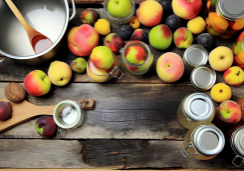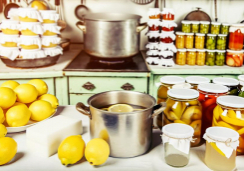Secrets to Perfecting Homemade Italian Pasta
Imagine you're standing in a rustic Italian kitchen, the scent of fresh basil wafting through the air, as you sprinkle a handful of semolina on a marble countertop. You've embarked on the timeless art of pasta making, a craft that's both simple in concept and profound in depth.
As you begin, you understand that every detail, from the quality of the wheat to the temperature of the water, intertwines to create the perfect al dente noodle. You're about to learn that the difference between good and exceptional homemade pasta lies in a few pivotal secrets—techniques passed down through generations of Italian nonnas.
But as you roll out the first sheet of golden dough, you realize there's much more to uncover about the finesse needed for each shape, the exact resting times, and the delicate balance of flavors that will transform your dish from a mere meal to a culinary experience.
So, where do you start, and what are the subtle nuances that elevate a simple dough into a masterpiece of Italian cuisine? Let's explore the elements that promise to guide your hands to pasta perfection.
Selecting Quality Ingredients
When crafting homemade Italian pasta, choosing top-notch ingredients like 00 flour or semolina is crucial for achieving that authentic, delectable texture and taste. The 00 flour, a finely ground Italian flour known for its powdery texture, is the gold standard for creating silky-smooth pasta. Semolina flour, on the other hand, imparts a heartier, more robust flavor, lending your pasta that classic Italian bite. Both are quintessential flours for pasta, ensuring your culinary creations rival those of seasoned Italian nonnas.
Don't overlook the role of fresh, organic eggs in your pasta dough. They enrich the pasta with a luxurious richness and a color that's as appealing to the eye as it is to the palate. For an extra touch of sophistication, reach for extra virgin olive oil. Just a drizzle can add a subtle richness and depth, enhancing your pasta's flavor profile.
If you're feeling adventurous, infuse your dough with freshly chopped herbs, elevating the aroma and taste. And when you're aiming for that vibrant, golden hue in egg-based pasta, opt for eggs from corn-fed chickens.
With these high-quality ingredients at your fingertips, you're set to create fresh pasta at home that's worthy of the most discerning Italian recipes. Whether you're kneading by hand or using a Kitchen Aid pasta attachment, you're on your way to a masterpiece.
Crafting the Dough
To craft the perfect pasta dough, you'll need to start by precisely weighing your ingredients, including the eggs, to ensure the final dough has the ideal texture. Select a high-quality flour, Fresh from the mill if possible, to provide a robust foundation for your pasta. Pour the flour onto a clean surface, make a well in the center, and crack the eggs into this crater. Using a fork, gently beat the eggs and begin to incorporate the flour from the inner rim of the well.
Once the mixture starts coming together, it's time to dive in with your hands. Begin kneading the dough, pressing and folding for 5-7 minutes until you have a soft, malleable texture. Your efforts now make for sumptuous bites later.
After kneading, shape your pasta into a ball and let it rest at room temperature. This half-hour respite allows the gluten to relax, making it easier to work the dough afterward.
When it's time, place the dough on a lightly floured surface. Using a rolling pin or a pasta machine with a thickness setting, roll the dough into sheets. Aim for an elastic dough that's thin yet durable, ready to be cut into your desired pasta shapes.
Rolling and Shaping
Ensure your workspace is long and free of clutter, then lightly flour the surface to prevent the pasta dough from sticking as you embark on rolling and shaping your culinary masterpiece. Once you've kneaded your dough to perfection, it's time to roll the dough into thin, even sheets.
Whether you're using a traditional rolling pin or a pasta machine with a pasta roller attachment, the goal is to make pasta sheets that are smooth and supple.
- Pasta Machine Perfection: Crank out uniform sheets of pasta by setting your pasta machine to the desired thickness.
- Manual Mastery: If you're rolling the dough by hand, use a rolling pin and work from the center outwards for even thickness.
- Cut with Confidence: Slice your pasta sheets into your preferred shapes, from elegant fettuccine to stuffed ravioli.
- Dry with Care: Before cooking, let your shaped pasta rest on a pasta drying rack to enhance texture.
- Flavorful Flexibility: Mix up your pasta dough with herbs or vegetable juices for an extra twist.
Rolling and shaping the pasta is as much an art as it's a science. As you roll the pasta, keep the sheets covered to prevent drying. When you've achieved the perfect pasta sheet, transform it into the foundation of countless delicious dishes.
Perfecting the Cooking Time
Mastering the cooking time of your homemade pasta is crucial for achieving that sought-after al dente bite. When you make fresh pasta, its thickness will dictate how long you'll need to cook it. Thinner shapes may need just a few precious minutes in boiling water, while thicker varieties like fettuccine require a bit more time to reach perfection.
As you cook the pasta, start testing it a couple of minutes before the time you've estimated. This precaution helps prevent the pasta from becoming too soft, ensuring the pasta maintains its delightful chewiness. Remember, fresh homemade pasta cooks much faster than the dried kind, so don't take your eyes off the pot!
To fully capture the essence of Italian cuisine, consider transferring the pasta directly from the boiling water to the simmering pasta sauce. This seamless move not only saves time but also allows the pasta to absorb the sauce's flavors, creating a harmonious dish. So, keep your sauce ready and waiting as you cook fresh homemade pasta to ensure the pasta doesn't sit and stick together.
With these tips, you'll serve up an impeccable plate of pasta every time.
Pairing With Sauces
Selecting the ideal sauce for your pasta shape is as much an art as it's a science, with each combination designed to highlight the pasta's texture and maximize flavor. When you make homemade pasta, consider the interplay between your homemade pasta noodles and the sauce you choose. It's about creating a harmonious dish that brings out the best in your Italian homemade pasta recipe.
Here are some tips to keep you intrigued and ensure your pasta recipes shine:
- Match spaghetti with smooth sauces that coat each strand evenly.
- Use penne to trap hearty, chunky sauces in every bite.
- Pair delicate angel hair with light sauces like olive oil and garlic.
- Combine flat fettuccine with rich, creamy sauces for a luxurious experience.
- Choose ridged rigatoni for its ability to hold onto chunky sauces.
Imagine twirling your fork in a bowl of spaghetti bathed in a Sun Dried Tomato sauce, or savoring the nutty notes of Brown Butter over homemade Cheese Ravioli. The joy of making homemade pasta is in these perfect pairings, where each forkful is a testament to your culinary craft.
Enjoy the journey of discovering the ultimate sauce for your next homemade pasta masterpiece.
Frequently Asked Questions
How Do You Make Italian Pasta Taste Better?
To make your pasta taste better, focus on flour selection, perfect water ratio, thorough dough kneading, and optimal resting time. Choose the right pasta shapes, fresh ingredients, and sauce pairing for enhanced flavor and texture.
What Is the Secret to Perfect Pasta?
To craft perfect pasta, you'll choose the right flour, nail the water ratio, master the kneading, allow for resting, roll to ideal thickness, cut with style, dry properly, and pair with a complementary sauce.
What Makes Homemade Pasta Better?
Homemade pasta's superiority lies in its texture control and fresh ingredients. Flour selection, kneading technique, and dough hydration are crucial. Resting, rolling consistency, cutting precision, and sauce pairing elevate it using age-old recipes.
How to Make Pasta Like Italians?
To make pasta like the Italians, you'll need durum wheat for the right dough consistency. Master kneading technique, allow resting periods, roll to desired thinness, choose cutting styles, and pair with fresh, regional sauces.
Conclusion
Now that you've mastered the essentials, relish in the art of homemade Italian pasta. With top-notch ingredients, impeccable dough, and precise shapes, your kitchen will echo Italy's culinary spirit.
Remember to cover the dough and mind the cooking time—a dance of minutes to al dente perfection. The final flourish? A sauce that sings in harmony with your pasta's form.
Buon appetito—your hands have crafted a feast that's nothing short of a masterpiece.










